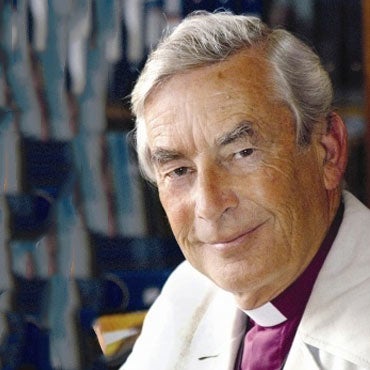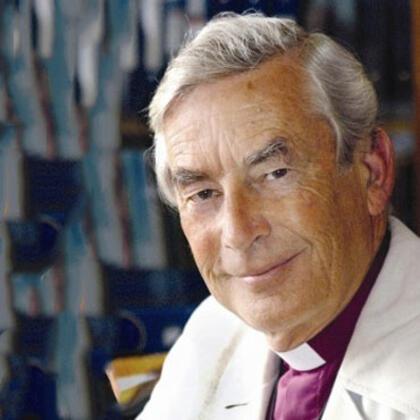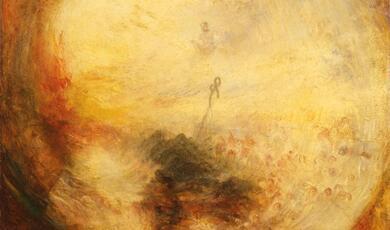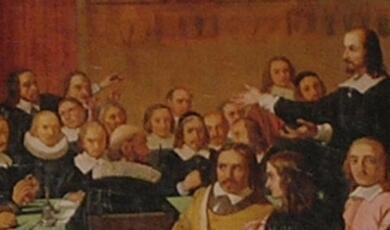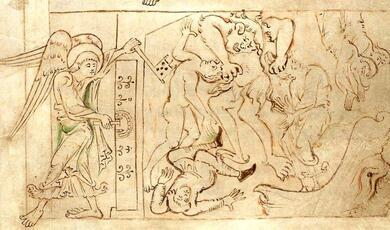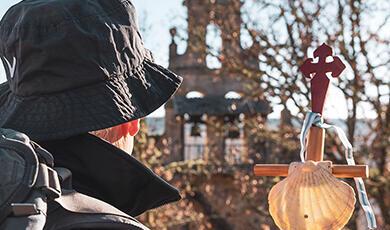The Explosion of Modernism
Share
- Details
- Text
- Audio
- Downloads
- Extra Reading
The period before World War 1 saw an extraordinary burst of creativity in all the arts which has decisively effected all subsequent developments. This lecture will look at the emergence of expressionism and amongst other artists will consider in detail the work of Nolde, Jacob Epstein and Roualt.
This lecture is part of Lord Harries' series on Christian Faith and Modern Art. The last century has seen changes in artistic style that have been both rapid and radical. This has presented a particular problem to artists who have wished to express Christian themes. These illustrated lectures will look at how different artists have responded to this challenge whilst retaining their artistic integrity.
The other lectures in the series are:
Distinctive Individual Visions
Catholic Elegance and Joy
Post World War II Optimism
Searching for new ways
Contemporary Christian Art
Download Text
19 October 2011
Christian Faith and Modern Art
The Explosion of Modernism
The Rt Revd Lord Harries
Prologue
Christian art once provided a shared “symbolic order” (Peter Fuller). Shared narratives and recognised images through which the deeper meaning of life could be explored. This has gone. “The disassociation between art and faith is not written in stone but is not easy to overcome”. Formidable obstacles: of style-how to avoid pastiche, images that have gone stale-overwhelming plurality of styles, so artist has to choose-forced to choose a private language, and so lose some of the audience. [1]
David Jones, particularly aware of this. Human beings are essentially sign makers. Most obviously we give someone a bunch of flowers or a kiss as a sign. So what are works of art a sign of? Here we come across the great crisis with which Jones wrestled both in his writing and his art. For he believed, and he said this view was shared by his contemporaries in the 1930’s, that the 19th century experienced what he called “The Break”.[2] By this he meant two things. First, the dominant cultural and religious ideology that had unified Europe for more than a 1000 years no longer existed. All that was left were fragmentary individual visions. Secondly, the world is now dominated by technology, so that the arts seem to be marginalised. They are no use in such a society, and their previous role as signs no longer has any widespread public resonance. Their work was “idiosyncratic and personal in expression and experimental in technique, intimate and private rather than public and corporate.”[3] “The priest and the artist are already in the catacombs, but separate catacombs, for the technician divides to rule”[4] There was no corporate tradition and one could not be looked for without a renewal of the whole culture. Writing after World War II he remarked that the situation at that time was even more pronounced and dire than it had seemed in the 1930’s.[5]
Radical and rapid changes in style in 20th century. How did artists who wished to convey traditional Christian themes do so whilst retaining their artistic integrity? Not dealing with 20th century art as a whole, which may or may not have a spiritual dimension, and which may or may not resonate with some echo of religious iconography. The focus is on paintings with a fairly recognisable Christian image-some Jewish.
Modernism
1913 in Paris-Joyce, Stravinsky. Pound, Eliot.
Before World War I with expressionism-break with representational art-the expression of intense feeling through colour, line etc, overtones of violence. Began earlier in 19th century-but France and Germany in 1905-Die Brucke (The Bridge). Tillich-two forms of art that cannot reveal transcendent-naturalism i.e. landscapes and portraits of 18th century-concerned to show world as it appears to the eyes. Purely abstract art, because Christianity does need some figurative expression. Expressionism is his ideal.[6] Two principles, consecration, that is truth to revealed forms-and honesty, or artistic integrity. Potential tension. “History shows that those styles in which the expressionistic element is predominant lend themselves most readily to an artistic expression of the Spiritual Presence.”
Nolde (1867-1956
Christ with children
Last Supper
Pentecost
Crucifixion
Short time a member of Die Brucke group.Brought up on a Danish Farm which had been in his mother’s family for 9 generations. Parents deeply religious Friesian peasants-religious themes occur, and a visionary sense that all nature was alive and demanded that he paint it. Supporter of Nazis, but did not stop his art, like all expressionism being condemned as degenerate.
Beckmann(1884-1950)
The Descent from the Cross
Night
Rejected term expressionism and what it signified. Part of “New Objectivity”- An outgrowth of expressionism but opposed to its introspective emotionalism. Admired Northern European artists like Bosch, Breugal and Grunewald. Impact of World War I.
“In my paintings I accuse God of his errors..my religion is hubris against God, defiance of God and anger that he created us (such) that we cannot love one another”. Suffering of war, but like Kandinsky and Mondrian interested in the spiritual in art. Effort to move “from the illusions of life towards the essential realities that lie hidden beyond.” “His tragic experience seeks a formula of redemption” (Hans Belting). Mary? Pointing indicates this?
Otto Dix (1891-1969)
Ecce Homo II (1946-8)
Christ and Veronica(1943)
Veronica’s Face
Impact of World War I-paintings of disabled veterans and poverty. Adopted Neue Sachlichkeit approach. Called up in 1943-one of artists who faced the horrors( not abstract) –suffering human beings merged into suffering Christ. Christ as prisoner of war-barbed wire as crown of thorns. Artist in corner pointing.
1943-investigated by Gestapo. Not Roman soldiers but thugs, passive spectators.
Jacob Epstein (1880-1959)
Self Portrait with beard 1920
Epstein was born in New York in 1880 at a time when it was packed with refugees from all round the world. He early developed a facility for drawing and when his parents left the city he stayed behind, rented a room to make a studio and went out into the streets to draw some of the fascinating people he saw there from all round the world. He soon developed a strong conviction that he should be a sculptor and knew he had to go to Europe both to see great works from the past and meet modern sculptors of quality. He studied in Paris and in 1905 came to London, eventually taking out British Citizenship.
Maternity 1908
At the age of 27 he was commissioned to carve some statues on the front to the new BMA headquarters in London. The result was some very strong, primal images of birth and maternity which deeply shocked people at the time. This indicates one of the defining features of Epsteins life-the sense of outrage that his carvings aroused. For example, the BMA building eventually came into the hands of the then Southern Rhodesia when, on inadequate grounds of safety, the carvings were almost totally obliterated. However, his work continued to develop and this resulted in some superb carvings in flenite and marble. More controversial was:
Rock Drill 1913/15
This was regarded as part of the Vorticist movement of the time, and in a reproduced form was recently seen again in the Voricist exhibition in Venice and London
The Risen Christ
Called up in World War I Epstein had something of a breakdown but out of this and his sense of horror at the war, there emerged his Risen Christ. Epstein was Jewish, and had a Jewish upbringing, a point I will consider a little later, so how was it that his first major work with a religious theme should be such a distinctly Christian image? In his autobiography he tells how in New York as well as drawing, he read prodigiously and specifically mentions two book, Dostoevsky’s The Brothers Karamzov, which is of course perhaps the most profound and searching of all novels which explore the issues of belief and non belief from a Christian perspective, and the New Testament. The face for this work was based on a friend and great supporter of his, Bernard Van Dieren who lay very ill. Dieren’s head for Epstein had a mystical quality, and he made a mask of it “The Mask was filled with suffering, but it was so noble and had such a high quality of intellectual life, I thought of him as the suffering Christ”-and from this he made his first image of Christ in Bronze, which he extended into the full length Risen Christ.[7]
One of the features of this work is the way that Christ points to the wound in his hand. This was an expression of Epstein’s revulsion at the carnage of the war. Many years later, during World War II he wrote about it “I must maintain that my statue of Christ still stands for what I intended it to be. It stands and accuses the world for its grossness, inhumanity, cruelty and beastliness.” He is not the artistic Christ of the past said Epstein “but the modern living Christ, compassionate and accusing at the same time.” He said he would like to remodel it to make it hundreds of feet high and set it where all could see it where “it would give out its symbolic warning to all lands. The Jew-the Galilean-condemns our wars, and warns us that “Shalom, Shalom” must still be the watchword between man and man.” Later, when he retuned to that work he felt he had achieved what he wanted. I recognised, he said “How in this work I realised the dignity of man, his feebleness, his strength, his humility and the wrath and pity of the Son of Man.” [8]
Kathleen Garman
The Visitation 1926
Genesis 1929/30
Epstein’s personal life was, as they say, irregular. He had a wife to whom he was, in one way, devoted. But he had other loves, in particular Kathleen Garman, with whom he lived for 30 years and by whom he had three children in addition to the other two he had. Kathleen was the greatest of his loves and when his wife died, he married her. Before that he had maintained two separate homes, the one having no contact with the other. The Visitation, ostensibly about the pregnant Elizabeth visiting Mary, is modelled on Kathleen pregnant with their first child. He wrote that the figure “expresses a humility so profound as to shame the beholder who comes to my sculpture expecting rhetoric or splendour or gesture.”[9] A few years later he produced Genesis, a more elemental and universal expression of motherhood.
Day and Night 1928/9
Day and Night were carved for the outside of what was then the headquarters of the London Underground Electric Railways, and which today is above St James’s Park tube station, where they can still be seen. Despite the angry reaction to his previous work the architect of this building and other architects saw in Epstein the artist they wanted for sculpture on the prominent facades to their buildings. These statues of Epstein reveal a fundamental feature of his work: the inspiration provided by the carving of early cultures, African, Oceanic and Aztec. Indeed he himself developed one of the best collections of such sculptures.
Behold the Man 1934/5
Once again of course there was a furore over these carvings and despite the wishes of other architects; he had no major public commission for a further 20 years. This and other rejections may have led him to carve his monolithic Behold the Man which could not find a buyer for many years butwhich now stands in the ruins of the old Coventry Cathedral. It is a powerful work, which again draws on the primal energy of the sculpture of earlier societies. It shows Christ suffering but intrepid; compassionate but steadfast against the opposition.
There were howls of outrage and derision at Behold the Man. The Mirror even refused to show a photo of the statue, gaining plaudits from its readers for the decision. Epstein noted however that “Actually my religious statues have had strong support from the clergy”[10] In addition there was occasional support from art critics, including a particularly good article by Anthony Blunt in the Spectator.[11] What Blunt wrote there is highly relevant to understanding the fundamental problem facing those who wish to produce religious art in our times. For, as Blunt pointed out, in a society where religion is a natural part of life, religious art emerges with equal naturalness. But since the Enlightenment religion has not been woven into the texture of our culture, and artists who wish to convey a religious vision will almost invariably produce a work which is more private, contrary to the dominant culture, even idiosyncratic, a good example being William Blake (1757-1827). In the 19th century an attempt was made to solve this problem by a revival of a medieval style, with the Gothic Revival, or the early Italian style in the case of the Pre-Raphaelites. As Anthony Blunt wrote “The great difficulty which has faced religious artists in Europe for about a century is that our natural tradition for expressing religious feeling is utterly used up and dead.” Epstein responded, as I have said, by drawing on the primal energy of earlier non-Christian cultures, as indeed did a number of other artists at the time. Blunt thought that Epstein had produced a powerful work, but that it was not in every way a success, because in clearing away sentimentality and concentrating on essentials there was perhaps too great a simplicity of expression.
Epstein survived financially at this time with his portrait heads, which were widely appreciated. It is also important to note that he began to have an important influence on people like Barbara Hepworth and Henry Moore by whom he was much admired.
Cosummatum Est 1936
Not long after Behold the Man Epstein produced “Consummatum Est”. This brings out another fundamental point about his work. It was the stone, the shape and the material of the stone which dictated the direction he took. He would see a vast block of Subiaco marble, as he did with Behold the Manand a long piece of Alabaster as he did with “Consummatum Est” and keep it in his studio for a long time, looking at it until he saw various shapes in it. It was this, even more than the figurative image, that he sought to bring out with his carving. He conceived the final form for this work after he had been listening to Bach’s B Minor Mass. “I see the figure complete as a whole. I see immediately the upturned hands, with the wounds in the feet, stark, crude, with the stigmata. I even imagine the setting for the finished figure, dim crypt, with a subdued light on the semi-transparent alabaster.”[12]
The art critic Richard Cork on his book on Epstein expresses admiration for this work. Noting the title, translated into English as “It is finished” he wrote that this title “does not match the sculpture’s sense of residual strength. The head is still raised, as though resisting extinction, and the thrusting feet are obtrusive enough to suggest latent energy…If death is the theme here Epstein insists on exploring it with a characteristic sense of resilience.”[13] What Cork seems to have overlooked is that the words are of course the final words of Jesus as recorded in St John’s Gospel. John’s picture of Jesus, particularly his death is very different from that of the other Gospels. In John he goes to his death as a king, not buffeted by events but in control of his destiny. He came to fulfil the will of his heavenly father and the great cry, “Consummatum Est “It is finished” refers to the great work of doing that will which has now been accomplished. It is not an acknowledgement of defeat but a shout of triumph. So Epstein in his depiction of resilience has indeed caught something of the character of the Jesus as portrayed by John.
Adam, 1938/9
Jacob and the Angel 1940/1
People were puzzled that Epstein, a Jew, should depict so many major Christian themes. So something about his religion, first of all his Judaism. Brought up in a very Jewish Quarter of New York, a bit of Polish Jewry simply transplanted there, his father was a leading member and benefactor of the synagogue. In his household there were daily prayers, bible readings and Hebrew lessons. On the Sabbath the young Jacob had to spend most of the day in synagogue. He duly went through his Bar Mitzvah. He found all this stifling, and distanced himself from it as soon as he could. However, it gave him a deep knowledge and love of the Bible, and a sense of the sheer power of the Biblical stories, as for example we see in sculptures such as Adam, and Jacob wrestling with the angel.
Whilst in New York he was as it were taken up by people in a settlement there. This settlement was no doubt very like such institutions founded by educated people in England at the time, usually with a strong Christian motivation, to enhance the lives and open up wider opportunities of those living in the slums of some of big cities. Epstein found that this wider world liberated him from the stifling confines of the Jewish ghetto, and introduced him not only to Christians who were an influence on him but Yiddish intellectuals who had similarly thrown off their religious upbringing. In particular a Mrs Moore befriended him and believed in him when he had lost faith in himself. [14]
Lazarus 1947/8
In the foyer of the chapel of New College,Oxford.
Lazarus, looking back. “This happy region of death from which he drags his eyes so unwillingly-what is it?” (Austin Farrer).
Christ in Majesty 1954/5
After World War II some of his sculpture seemed more accessible and acceptable to the general public. The new found confidence after the war led to some important commissions by the church, like this at Llandaff Cathedral.
Madonna and Child 1950/2
Coventry Cathedral was almost totally destroyed by bombing in 1940 and in the early 1950’s Basil Spence was commissioned as the architect for the building of a new Cathedral. He invited Graham Sutherland, John Piper and Elizabeth Frink to do work for it. He also wanted Epstein and in 1954 took Bishop Gorton to look at the Madonna and Child in Cavendish Square. The bishop stood looking up at it, oblivious of the traffic and said simply “Epstein’s the man for us.” Later when Epstein’s name was brought before the committee Basil Spence noted “There was a shocked silence, at length broken by the remark, ‘But is he a Jew’, to which I replied quietly, ‘So was Jesus Christ’”[15]
St Michael and the Angel 1956-8
At this meeting Epstein was asked about his faith, to which he responded by saying it could be seen in his work. In a radio broadcast he enlarged on this.
My tendency has always been religious-it may not be known, but that is a fact…most great sculpture is occasioned by faith. Even the African sculpture, which we don’t understand, is full of their faith.[16]
So Epstein was an innately religious person whose upbringing on the Hebrew scriptures had gone deep. The other fact, in addition to the friendly encouragement by Mrs Moore and others at the settlement in New York was his life long friendship with some Christian intellectuals and clergy. He and Eliot became friends and Eliot was amongst a small group invited to Epsteins 70th birthday party and the one who lit the candles on the cake.[17] When Epstein died Eliot wrote to his widow to say “It is as if some of my world has crumbled away.We loved him.”[18] Epstein was buried at Putney Vale cemetry, with Dr Hewlett Johnson, the Red Dean of Canterbury taking the service. A memorial service was held at St Paul’s Cathedral, at which his friend Canon Mortlock said
If we ask how it was that a boy born and bred in the Jewish faith and never embracing any other, should become the interpreter of the sublime mysteries of our religion there can be no clear answer. Such things belong to the inscrutable wisdom of God.[19]
Rouault (1871-1958)
Photo of the artist at work
The workman’s apprentice (self-portrait)
Rouault was born in a working class area of Paris in 1871, his father being a cabinet maker and polisher of pianos. From him Rouault derived his respect for good workmanship, as captured by his remark that he would rather be a good artisan than a sloppy artist. Here he is shown in his working clothes rather like a baker. His father was galled even by the sound of a door squeaking, “as if wood itself were being made to suffer.” Perhaps this is one of the sources of Rouault’s extreme sensitivity to human suffering.
In the Old district of long suffering
Take refuge in your heart, vagabond of misfortune
Lonely in this life of pitfalls and malice
The other decisive influence was the poverty of the people around him. He never lost his profound sympathy for the those burdened by life. In this respect he is like Rembrandt, another deeply Christian artist. Other artistic models for him were Goya, who also of course painted the dark side of life, and Cezanne.
“Art, the art I aspire to, will be the most profound, the most complete, the most moving expression of what man feels when he finds himself face to face with himself and with humanity. Art should be a disinterested, passionate confession, the translation of the inner life, as it used to be in the old days in the hands of our admirable anonymous Frenchman who sculpted the figures on the cathedrals.”[20]
Prostitutes
At 14 he was apprenticed to a stained glass maker, and the influence of this early training can be clearly seen in all his work, with its heavy black lines and blocks of colour. In the evenings however, he took art classes and then studied at the Ecole des Beaux arts under Gustave Moreau, Mattisse being a fellow student, and where Rouault won a prestigious prize. Moreau encouraged the individual talent of each student, and indeed with this in mind encouraged Rouault to leave the college, though he continued to give him private lessons afterwards. Moreau’s death in 1898 sent Rouault into a major crisis and that too is reflected in his paintings. Before then, though talented and innovative, his style recognisably belonged to the tradition of the great European masters. Now he painted with “an offensive lyricism”, his subjects being prostitutes and marginal people of the streets. He could paint nudes of great beauty in a way that showed the influence of Cezanne, but it was in the depictions of prostitutes that he showed his distinctive style and view of life. Unlike other artists of the time he showed them as neither romantic nor erotic, but as human sufferers-abused and knocked about by the life they led. As he put it “behind the eyes of the most hostile, ungrateful, or impure being dwells Jesus”.
Clowns
Who does not put on make-up?
Also from this period of his life are his portraits of clowns and other circus performers. There was a moment of revelation in 1905 when he wrote to a friend about what he had just seen. “The wagon of nomads halted in the middle of the road, the tottery old horse grazing the spare grass, the old clown in a corner of his wagon mending his shiny and no longer motley costume; the sharp contrast between the shiny glistening things that are meant to amuse and this exceedingly sad life, at least when I observed it from afar. …later on, I clearly realised that the clown was myself, he was all of us, almost all of us.” In contrast to other artists of the time, who depicted the gaiety of such scenes, he saw the sadness. We put on a mask for others, but inside life often feels different. “Behind our glittering masks, we all hide a tormented soul, a tragedy.” The mask and the make up cannot hide the wrinkles and the sadness of the gaze. Here as in his other paintings it is the face which is always so powerful. The intensity of feeling in a face is usually highlighted by some contrast with the clothing. In pictures of clowns for example, the clothing can be bright, even garish but we are caught by the haunting individuality and isolation of the face. As he wrote “I saw clearly that the “Clown” was myself, it was all of us (or almost all). The rich, spangled garment is given to us all to wear, and we are all clowns to a certain extent, we all wear “Spangled garments”, but if someone glimpses us unawares (as I glimpsed the old clown), oh! who can truthfully claim not to be moved to the very depths of his soul by enormous pity. My fault (if it is a fault, at any rate it causes me untold suffering) is never to leave anyone their spangled garb, be he king or emperor. It is the soul of the person standing in front of me that I want to see … and the greater the person, the more extolled he is as a human being, the more I fear for the good of his soul. “Who wears no disguise?” was a title he used for a number of his paintings.
Three judges
Another major theme from 1907-14 was that of judges in the courtroom. But here again his stance is distinctive. He did not paint them simply to condemn an oppressive system any more than his paintings of prostitutes were designed to be social comment. What struck him was the anguish of human beings having to judge other human beings. So a judge’s features could sometimes be identical with those of the defendant. “all the riches of the world could not make me take on the position of judge.”
The Old King
What he felt about judges is not dissimilar to what he felt about those who had to rule, as in the well known painting of the old king-a king who looks burdened by his crown, the weight of ruling. There were of course many who criticised his paintings and deplored his switch from an earlier more pietistic style. As Leon Bloy put it “If you really were a devout man you would not paint such horrible canvases”. But that is to misunderstand the effect which religion has and perhaps ought to have. As Rouault put it “I don’t believe in vague and tremendous theories or ideas about the otherworld since, in practice, they are lifeless and not viable. I abhor such wanderings of thought and action. They can only culminate in a soggy and facile idealism which, in its arrogant attempt to explain and sort everything out, ends up blunting the edges and wearing the fabric until it becomes threadbare. Holding such bland softening in horror, I much prefer cynicism, and even the most grotesque or violent form of realism.” This is an unusual statement coming from a devout believer. It is not surprising that he was also capable of satirical sketches. His more perceptive catholic friends could understand what he was trying to achieve, not least Father Jaques Maritain, whom as we have seen was a friend of Jacob Epstein, and we will see in the third lecture a big influence on both Eric Gill and David Jones. Religion was inseparable from every aspect of life, all art is sacred, or as Rouault put it “There is no such thing as sacred art: there is just art and that is enough to fill ones lifetime.”
This will be the last time, little Father
My sweet country, where are you?
Homo homini lupus
We are insane
Rouault did paint some pictures with more joi de vivre in them, as well as landscapes and still lifes but it is the darker theme that we particularly associate with him, no doubt significantly due to his personal sensitivity to human suffering, but few would deny that it was a temperament that expressed one inescapable aspect of life, not least in the cruel 20th century. Rouault did a series of woodcuts from 1917-27, “Misere”, from the refrain Lord have mercy on us, on the misery of war, which were finally published in 1948.[21] He also painted this painting with its title words of Plautus, homo homini lupus. Rouault brings to mind the words of Wilfred Own “The poetry is in the pity.”
Head of Christ 1937
Christ with onlookers
Christ mocked by soldiers 1932
The Flagellation
Eternally flagellated
Jesus will be in agony until the end of the world
From about 1914 onwards religious themes become an important part of his work, but has been rightly noted, the characters depicted and the view of life behind them did not fundamentally change. The bowed figure of Christ reflects the bowed figures of his paintings of burdened humanity generally. Christ condemned to death re-images the criminal in the courts he saw being condemned to death.This is fundamental to understanding what is meant by calling Rouault a religious or Christian artist. For him, as mentioned, all genuine art was sacred art. As he said about his painting of “The injured clown” painted in 1932, “In my view it is quite as religious as compositions with a biblical theme. To call a work ‘sacred art’ it is not enough to invest it with religious significance.” He gave one of his pictures a quotation from the French philosopher Pascal, “Christ suffers until the end of the world”. Like so many 20th century poets, writers and theologians Rouault’s understanding of God is that he is above all one who shares in the suffering of humanity through Christ.[22]
At times the road is beautiful
It would be sweet to love
Sing Mattins, a new day is born
He that believeth in me, though he were dead, yet shall he live
Despite his awareness of the suffering and darkness of life Rouault believed that there were glimpses of hope and love along the dark road of life, and the journey is to be undertaken with hope for the dawning of a new eternal day.
The Holy Countenance
De Profundiis
The Crucifixion
The Mandylion, based on the story of the image of Christ on Veronica’s cloth, was a central image of Christian art for 1000 years. It reminds us that Christ is present and brings strength to us when we are in the depths. In the picture shown here, painted abut 1920, the dark is once again a fundamental feature. The Crucifixion could almost be taking place at night. The sky is dark, the land is dark and the outline of the Cross is black. This serves to focus the eye of the viewer on the unearthly light of Christ’s body and the faces of those by the Cross. That light is not bright, rather it is a paleness that emphasises the humanity and vulnerability of the flesh.The figures either side of the Cross are absorbed in the suffering in their own way. To the right John lifts his neck and face ardently in the direction of Jesus. To the left Mary kneels in devout prayer. The intense attention of these two helps to draw the onlooker into the picture and to make their own response. The head on one side, with the eyes half closed, looks down gently and questioningly at the onlooker. This is not just a painting for public art, to be viewed from afar. It is a deeply felt personal response to the Crucifixion which itself seems to require a personal response.
Crucifixion
We see his fundamental themes in his many subtle variations on his depiction of Christ crucified, where the viewer is brought up so close that the feet are cut off. In the picture of Christ mocked and the sacred face. It is no accident that these often have the feel of Byzantine art, or folk art, with something of their anonymity. For Rouault saw his vocation not as one of self-expression as the 20th century came to understand it but as one of obedience to his personal vision, a vision which he interpreted in profoundly Christian terms. As he put it, “I am obedient. Just about anybody can be a rebel; it is a much more difficult undertaking to obey silently the dictates of one’s soul and to spend ones life looking for the truest means to express ones temperament and talents.” Having been at the cutting edge of art at the turn of the century, he was enabled to find his own voice, and to that he sought to remain true amidst all the succeeding changes of artistic fashion. His work appeared in the prestigious Salon d’automne exhibition of 1905, which was labelled fauvist the wild ones, because of the vivid use of colour. But there was more to Rouault than that. Nor did he belong amongst the feverish German expressionists, nor to the French ones, for he was the French one, with his own highly distinctive stance and style. Many would say he is the most profound of the artists who drew on Christian imagery in the 20th century.
©Lord Harries, Gresham College 2011
[1]Roger Wagner, “Art and Faith”, in Public Life and the Place of the Church: Reflections to honour the Bishop of Oxford, ed. Michael Brierley, Ashgate, 2006, p.133
[2]The Anethemata, p.15
[3]David Jones, “Religion and the Muses”,(1941), in Epoch and artist, Faber 2008, p.98.
[4]Ibid p.103
[5]David Jones, “Notes on the 1930’s,” (1965) The Dying Gauland other writings, Faber, 2008, p.49
[6]PaulTillich, Systematice Theology, vol III, Nisbet, 1964, pp 210-14
[7]Jacob Epstein, Let there be Sculpture: the Autobiography of Jacob Epstein, Michael Joseph, 1942, p.79, cited as Autobiography
[8]Autobiography, p.105/6
[9]ibid. p.115
[10]Autobiography, p.153
[11]Ibid. The article was printed in The Spectator on March 15th, 1935
[12]Authobiography, p.154
[13]Richard Cork, Jacon Epstein, Tate Gallery, 1999, p.54
[14]June Rose, Demons and Angels: A life of Jacob Epstein, Carroll and Graf, 2002, p.19 “But in his autobiography written half a century later, Epstein shabbily omitted the whole episode, ashamed perhaps to admit how much he had been helped by the University Settlement. Mrs Moore does not rate a mention.”
[15]Basil Spence, Phoenixat Coventry, 1962
[16]Interview on Home Service in 1952, quoted by June Rose, Demons and Angels, p.265
[17]Rose, p.251
[18]Rose, p. 275
[19]Cited in Richard Buckle, Jacob Epstein, Sculptor, 1963
[20]Fabrice Hergott and Sarah Whitfield Georges Rouault, Royal Academyof Arts, London, 1993
[21] Holly Flora and Soo Yun Kang, George Rouault’s Miserere et Guerre:this anguished world of shadows Museum of Biblical Art, NY, 2006
[22]Jane Dillenberger, Style and Content in Christian Art, SCM, 1965, p206ff
Part of:
This event was on Wed, 19 Oct 2011
Support Gresham
Gresham College has offered an outstanding education to the public free of charge for over 400 years. Today, Gresham College plays an important role in fostering a love of learning and a greater understanding of ourselves and the world around us. Your donation will help to widen our reach and to broaden our audience, allowing more people to benefit from a high-quality education from some of the brightest minds.


 Login
Login
